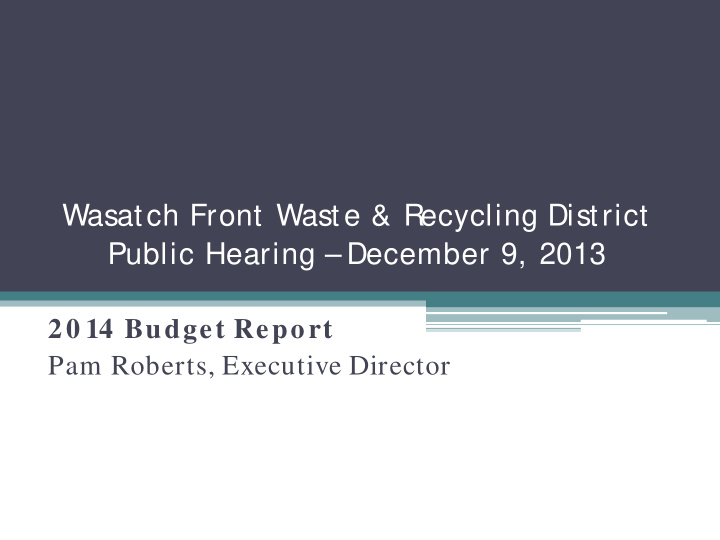



Wasatch Front Waste & Recycling District Public Hearing – December 9, 2013 20 14 Budget Report Pam Roberts, Executive Director
Wasatch Front Waste and Recycling District Mission to Fulfill Mandates 2 Provide sustainable integrated waste and recycling collection services for the health and safety of our community...because not everything fits in the can. There is approx. 147,000 tons of waste generated annually by 81,000 homes. Curbside refuse: 106,350 tons, disposal Tonnages and Associated cost @ $26 per ton = $2,765,100 costs for processing Area Cleanup: 10,524 * Curbside recycle : refuse tons , disposal cost 22,000 tons, revenue @ $273,624; green 877 tons $25 per ton =$550,000 & Saved $572,000 @ $16 per ton = $14,032 • Savings from not going * Special Services: to landfill = $8,770 2,504 refuse tons, Disposal cost = The $65,104; Integrated Recycling tons , 870 revenue @ Collection Emergency/ Disaster $25 = $21,750 Tonnage varies System (saved $122,620) pending situation Leaves: 1,250 Glass collection : tons, 420 tons to date; cost Disposal cost @ $3 per ton = $0 per ton = $3,750 • Savings from not (saved $32,500) landfilling = $10,920 Trailers: 500 bulk tons, disposal Christm as Trees: 101 tons, cost @ $26 per ton = $13,000; disposal cost @ $0 per ton = green 1,260 tons, cost @ $16 per $2,626 saved ton = $20,160
3 2014 Increased Costs Broken Out Per Home Per Month ($2.80 Per Month Total) Mandates for Retirement & Health Ins. $.10 Billing Market/ Salary Returned 2nd Garbage Cans = $880,000 $.10 Adjustments $.17 Landfill Garbage Fees = $616,520 Returned 2 nd Shop Rate Increase for Garbage Cans Depreciation & Lease Rate = $612,443 Truck Maint. $5 per hour $.90 $.26 Shop Rate / Maintenance = $238,675 Market / Salary Adjustments = $168,000 Depreciation & Retirement / Health Ins. = $101,442 Lease Rate for Hook Lift Trucks $.63 Billing = $99,700 Landfill Garbage Fees $.64
4 History of Increasing Costs by Type $4,000,000 $5 per ton increase ($31 per ton) $2 per ton increase $3,500,000 ($26 per ton) Dum ping Fees $3,000,000 $5/ hour labor increase $2,500,000 $5/ hour Maintenance labor increase $2,000,000 Fuel $1,500,000 $.37 increase Total decrease per home/ per month of $244,300 due $1,000,000 if we don’t convert to CNG. Price to CNG. decrease & mileage increase. $500,000 $0 2011 2012 2013 2014
5 Improved Efficiencies to Keep Costs Low 20 0 8 • Re-routed residential routes reducing miles traveled to absorb growth. 20 0 9 • Area Cleanup 4/ 10 schedule. Included parks and other facilities on residential routes where appropriate. Reduced mileage 85,000=$234,000. 20 10 • Implemented a 4/ 10 work schedule for equipment operators. Savings= $489,223 in 2012 and $200,000 ongoing. Increase recycling services for $1,000,000 less than 5/ 8 schedule. • Extended our fleet replacement schedule on 36% of our trucks going from three year to a four year replacement. Saving $3,400,000 over a ten year period in capital purchases. 20 11 • Extend PMs on trucks: $54,000 in savings annually • Researching “Eco Driving” behavior modification to save fuel. Some companies show 15% decrease in fuel costs. Potential $279,000 savings for the District. • Using alternative fuels such as bio-diesel. Exploring other options • Researching fuel additives to increase MPGs
6 Improved Efficiencies (continued) 20 12 • Implemented Eco-Driving principles to reduce idling. Saved $54,000 • Created specifications for CNG trucks to be purchased in 2013. • Developed partnership with Blu Stations and Questar Gas for CNG fueling options. • Created partnership with Biozyme for green waste disposal that reduced disposal costs by $990. • Refined “go-back” procedure to reduce miles. 20 13 • Diverted 650 tons of green waste from Landfill saving $5,800 in disposal fees. • Awarded a $79,000 grant from Utah Division of Environmental Quality to help fund CNG truck purchases. • Purchased 11 CNG trucks and realized $45,859 YTD Oct. savings in fuel costs. • Tested a new route collection structure that showed potential for maximizing capacity and illuminating partial loads at the end of the day. • Conducted route audits to determine efficiency and productivity and match to industry standards. • Reinstated Residential Bulk Trailer Rental program with higher fee that increased revenue by $22,250. • Worked with Landfill to eliminate need to rent a loader for leaf program and saved $7,600.
7 Improved Efficiencies (continued) 20 14 • Restructure routes and working groups to maximize capacity and meet increasing workload for an anticipated $225,000 savings in mileage costs. • Deferred the need to increase workforce by 1 FTE @ $53,000 PLUS deferred $282,000 capital cost by not expanding fleet by 1 truck. • Continue CNG purchases to increase fleet to a total of 25 CNG trucks by the end of 2014 for a savings of $292,000 in fuel at current projections. • Coordinating with SLCo Fleet for an onsite CNG fueling infrastructure to eliminate all offsite fueling by Nov. 1 2014 for an estimated savings of $31,780. • Evaluate Annual Area Cleanup program to find better, more cost-effective ways to serve isolated areas, such as Emigration Canyon, for an estimated savings of $24,000. • Pilot RFID program to determine potential cost savings for fuel, inventory-control, go- backs; and to target recycle education for increased revenue. Future • Full-fleet conversion to CNG for an anticipated fuel cost savings of $532,000 in 2015 and $660,000 by the end of 2016 at current projections. • Implement RFID program to maximize routing efficiencies, improve inventory-control, capture missed rental cart revenue, and increase recycling tonnage and revenue. • Expand curbside green waste to increase diversion rate and reduce disposal costs.
Recommend
More recommend